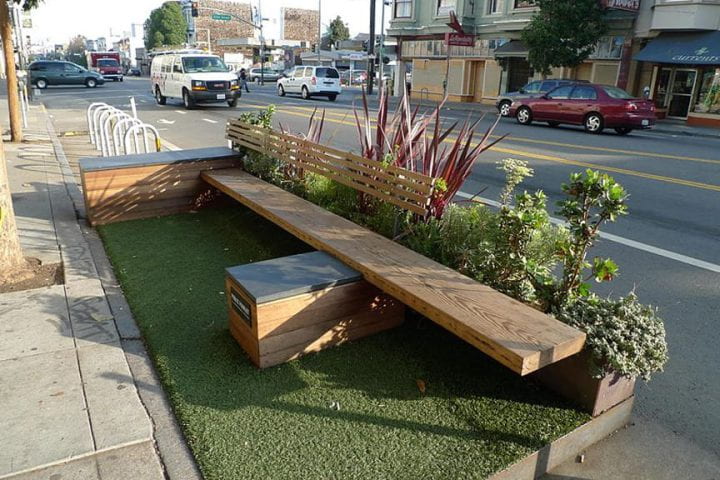Retrofitting for fitness
UCI’s master in urban & regional planning program celebrates 20th anniversary.

Garden Grove might be rich in cultural diversity, but it’s “park poor,” with less than 1 acre of park space per every 1,000 residents. A group of students in UC Irvine’s urban & regional planning master’s program is working to remedy this, recommending trails, “parklets,” crosswalks and public art to make neighborhoods more livable.
Focusing on an area that encompasses City Hall, a Korean business district and a large shopping center, the students prepared a public health assessment on the availability of healthy food, parks and pedestrian-friendly streets and concluded that parks, open space and “walkability” were the most pertinent issues in the community.
“This neighborhood in Garden Grove has a lot to offer,” says Connie Chauv, a senior majoring in urban studies. “There’s a retail district, a day care center and a library nearby but no easily accessible crosswalks or walkways to connect them.”
The targeted area also includes 1.5 miles of railroad corridor once part of the Pacific Electric Railway that connected Orange County with Los Angeles. Today the tracks are partially boarded up and surrounded by fencing.
“The railway cuts right through the heart of the city and connects the Civic Center with stores on Brookhurst Street and Chapman Avenue,” Chauv says. “It would be a perfect spot for a pedestrian trail, trees and perhaps some artwork to brighten it up.”
She and her urban planning classmates Aseel Danan, Nicholas Fung and Sunny Zheng Guo conducted a focus group with local residents to understand their concerns.
Facilitated by the Community Action Partnership of Orange County, the focus group led to the incorporation of safety measures in the students’ recommendations.
“The participants in our focus group expressed a real need for safe, marked crosswalks and streetlights so drivers can be more aware of pedestrians,” Chauv says.
The students are enrolled in a community planning practicum that emphasizes team project experiences and pairs them with the Orange County Health Care Agency to address health and wellness issues in low-income areas of five cities. The purpose of the course is for students to understand the connection
between urban planning and public health.
The agency’s FIT Cities initiative aims to support health-optimizing environments, with the larger goal of decreasing the county’s obesity rate to 15 percent by 2020.
“Overall, Orange County fares rather well when it comes to obesity and tobacco use compared to other counties in California as well as nationally,” says Amy
Buch, health promotion division manager with the OCHCA. “But when we look at Orange County at the subcounty level, we see that not all residents have the same opportunities to engage in healthy lifestyles. Our partnership with UCI’s master of urban & regional planning program has facilitated efforts in
those neighborhoods where there’s a need and also a desire to create more vibrant, healthy communities.”
Practicum projects involve neighborhood revitalization in San Clemente’s Los Mares section, increasing open space and parks in Garden Grove, ensuring open-space quality and accessibility in Stanton, improving food choices in Anaheim, and boosting senior health and walkability in Orange.
“The collaboration will offer city-specific plans to create environmental changes in low-income areas of five Orange County cities that both promote healthy
eating and active living and build communities that are safe, welcoming and stable,” says Victor Becerra, director of UCI’s Community Outreach Partnership Center.
In Anaheim, urban & regional planning grad students Jennifer Chirco-Coker, Rebecca Leda, Wen Deng and Xiaoxin Xia recently canvassed the Platinum Triangle region to gauge the availability of healthy food – such as fresh fruits and vegetables – in grocery stores, convenience stores and liquor stores. From there, they identified sites that could expand their selection to include nutritious food or increase their already wholesome offerings.
According to Chirco-Coker, Anaheim contains two “food deserts,” defined by the U.S. Department of Agriculture as low-income communities without ready access to healthy and affordable fare.
The Platinum Triangle is currently being developed as a high-density, mixed-use neighborhood, with office, restaurant and residential projects.
“We’re focusing on this area to ensure that it does not become another disadvantaged food environment,” Chirco-Coker says.
Her group is working with the OCHCA to identify grants and other funding sources to support merchants in converting their stores.
“Kids who walk to school are more likely to buy chips and soda because that’s what’s cheap and available,” Chirco-Coker says. “We believe people will choose healthy food when given the option.”
On April 3, UCI’s urban & regional planning master’s program will celebrate its 20th anniversary with a luncheon at the University Club featuring keynote speaker Henry Cisneros, executive chairman of CityView and secretary of housing & urban development under President Clinton. The event will raise money for the Raymond Watson Fellowship Fund in planning, policy & design, named for one of the master planners of the UCI campus and city of Irvine.